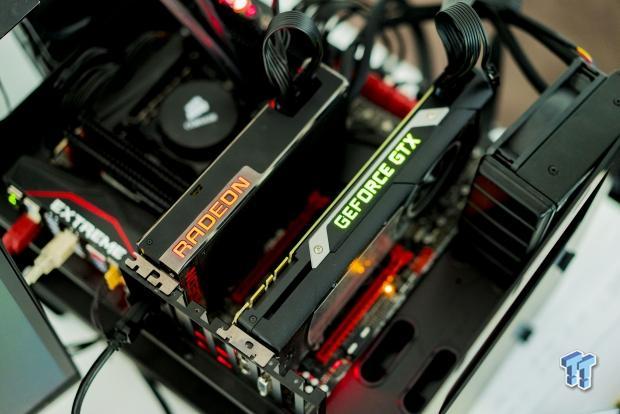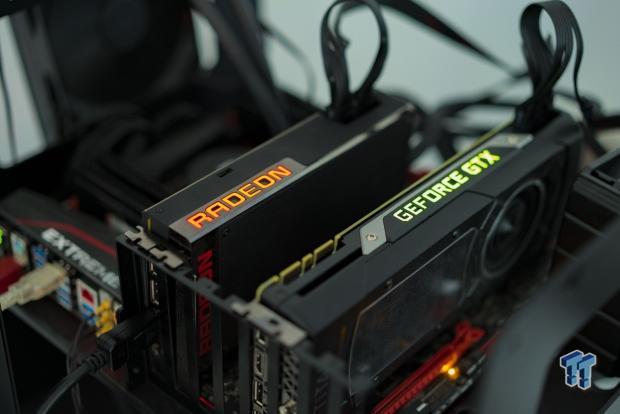Introduction & What You Need to Know
I wanted to spend considerable time on Ashes of the Singularity, as it's the first true DX12 benchmark that we can use on our GPUs. Our first test saw us use a bunch of GPUs from both sides of the GPU game, with this article covering the AMD Radeon R9 Fury X in Crossfire vs. NVIDIA GeForce GTX Titan X SLI.

These are the two fastest video cards from AMD and NVIDIA, so how do thousands of dollars of GPUs perform with DX12 in Ashes of the Singularity? Spoiler alert: not that great.
What You Need to Know
What you need to know about DX12 we covered in our original article 'DX12 benchmarked - Ashes of the Singularity with AMD and NVIDIA GPUs'. In this article we tested a slew of cards, including AMD's Radeon R9 390X, R9 Fury and R9 Fury X. We also tested NVIDIA's GeForce GTX 980, GTX 980 Ti and Titan X.

We tested our AMD and NVIDIA video cards at 1920x1080, 2560x1440, 3840x2160 and 3440x1440 - covering all of the bases. While I was testing out all of the cards individually, all I wanted to do was test multi-GPUs - mixing together an AMD Radeon R9 Fury X and NVIDIA GeForce GTX Titan X. Well, it was super fun - with results that didn't really surprise me. I expected much more, and you'll see these results on the next page.
Hardware Required & Our Test Setup
High Requirements, Which is Expected
Oxide recommends that you have 16GB of RAM or more, because if you don't, your benchmark scores might be lower than they should - which is due to disk paging. Oxide recommends between 16-32GB of RAM in order to benchmark Ashes of the Singularity.

On the CPU side of things, Oxide recommends you have a quad-core system at a minimum - I guess we should be fine with our Intel Core i7-5960X processor and 32GB of DDR4 RAM. You'll also need Windows 10 installed to make use of DirectX 12, as it's the only operating system in the world with DX12.
Anthony's Video Card Test System Specifications
- Motherboard: ASUS Rampage V Extreme - Buy from Amazon / Read our review
- CPU: Intel Core i7 5960X - Buy from Amazon / Read our review
- Cooler: Corsair H110 - Buy from Amazon / Read our review
- Memory: Kingston 16GB (4x4GB) HyperX Predator DDR4 3000MHz - Buy from Amazon
- Storage #1: SanDisk Extreme II 240GB - Buy from Amazon / Read our review
- Storage #2: Intel 730 Series 480GB - Buy from Amazon / Read our review
- Case: Lian Li PC-T80 Open-Air - Buy from Amazon
- Power Supply: Corsair AX1500i - Buy from Amazon / Read our review
- OS: Microsoft Windows 10 Home 64-bit - Buy from Amazon
- Drivers: NVIDIA GeForce 361.91 and AMD Crimson 16.1.1
Benchmark Results @ 1080p & 1440p
We're going to split this into a couple of pages, looking at 1920x1080 and 2560x1440 on our first page of benchmarks - while cranking things up to 3840x2160 (4K) and 3440x1440 (21:9 UltraWide) on the next page. We aren't really pushing our GPUs to their limits at 1080p, with the strain beginning at 1440p and continuing at 4K.
Ashes of the Singularity - DX12 - 1080p

Ashes of the Singularity - DX12 - 1440p

Benchmark Results @ 4K & 3440x1440
We continue our benchmarks of Ashes of the Singularity, this time at 3840x2160 (4K) and the 21:9 aspect ratio with 3440x1440.
Ashes of the Singularity - DX12 - 4K

Ashes of the Singularity - DX12 - UltraWide

Performance Summary & Final Thoughts
Performance Summary
With our single GPU benchmarks on Ashes of the Singularity, the AMD Radeon R9 Fury and R9 Fury X completely dominated the competition from NVIDIA in the form of the GeForce GTX 980 Ti and GTX Titan X. Well, history is about to repeat itself when it comes to multi-GPU tests, starting at 1080p where the Fury X CF setup beats the Titan X SLI setup by 12%. But, we're only at 1080p - so let's see what things are like at higher resolutions.

Moving up to 2560x1440, the R9 Fury X CF setup is once again the champion - with it 15% faster than the Titan X cards in SLI. Moving up to 4K, I expected some huge domination from AMD - and we get it. The Fury X cards in Crossfire are a huge 21% faster than the Titan X cards in SLI at 4K - a huge win for AMD. At 3440x1440, AMD beats NVIDIA with its Fury X CF setup by 16%, leaving the Titan X SLI setup in its dust.
Final Thoughts
Right now, AMD is cleaning up Ashes of the Singularity. But where to from here? Well, marketing wise AMD can take this and run. As it stands, consumers are going to see one thing: AMD is the leader when it comes to DirectX 12 gaming. It doesn't matter that Ashes of the Singularity is an RTS and not a more popular, better-selling FPS. It doesn't matter that Ashes is still in beta - marketing doesn't care about that.

Marketing cares about one thing: telling a story to the consumer. The story right now is that AMD is beating NVIDIA in DX12. NVIDIA needs to change things up with its upcoming Pascal architecture, and I'm more than confident it will, and things are going to get quite hot for AMD when it does.
AMD needs to keep this dominance happening, and if it can - it can pull itself out of the slump its created with losing huge swathes of its discrete GPU market share to NVIDIA. DX12 gaming isn't going to be huge this year, but it will begin its upward journey in 2016. As we move into 2017, it's going to become much more important, but this also comes down to game developers shifting into DX12 development - with the PC being the center of making their games and not APU-powered consoles.
It was great to see the Fury X in Crossfire and Titan X in SLI battle it out, but what about when their powers combined? Prepare yourselves for our next article which should arrive in another 24-48 hours, where we'll take a look at the Fury X + Titan X in various resolutions, working together.

